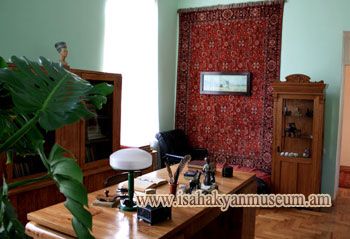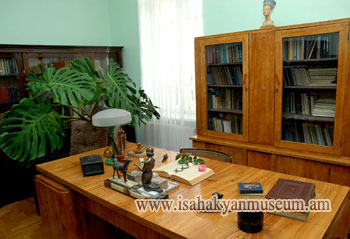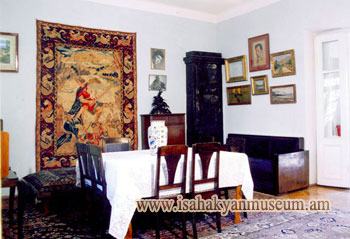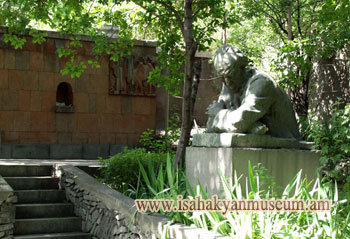Permanent Exposition »» Memorial Rooms
Poet’s study, bedroom and sitting room
The most sacred part of the museum is the poet’s study. Here you cans see Isahakian’s rich library, the old-fashion desk, sofa, personal belongings such as his pen, eyeglasses, rosary, the statuette “The Girl and the Deer”, stones from the island of Sevan...
 |
 |
The last verses by Isahakian had been created in front of this desk: “Everything is vain, a frail dream”, “To Avik” and some notes of his “Diary”, memoirs, letters and articles. The master liked to shut himself up here and worked until late at night.
 |
 |
The poet’s study is one of the memorial rooms where the poet accepted his guests. Literary gatherings and parties were held here, as well as the poet’s birthdays, New Year and Easter were traditionally celebrated here too. This house has hosted the great masters of our culture: Martiros Sarian, Hovhannes Shiraz, Hakob Kodjoyan, Silva Kaputikian, their holiness Gevorg VI and Vazgen I. Other famous people such as: Pablo Neruda, Jorji Amadeu, Nikolay Tikhonov, Georgi Leonidze, Maxim Rilski had been entertained here as well. The poet’s house had become a specific desirable place.
The memorial part of the museum is concluded with the poet’s modest and simple- furnished bedroom. The photo of his dearest mother Almast, hanging next to his bed, is very impressive, and had always been inseparable from Isahakian. In the morning of 17th October 1957 the poet passed away in his dream - as he himself had wished - unaware of the moment of death.
|
Natural continuation of the museum is the lovely garden. Far, in the garden, under the shadow of the trees, there is the tufa bench, designed by Rafayel Israelian, presented by the Armenian architects on his 80th birthday. A little farther, the bronze bust of Isahakian, created by Nikoghayos Nikoghosian, and the memorial wall made of tufa, designed by Norayr Karganian, were installed on the eve of the poet’s 100th birthday.
 |
 |
The exhibits in one of the rooms on the first floor of the museum and in the big hall on the second floor are illustrating Isahakian’s life and work. In the literary part of the exposition the poet’s handwritings, publications of various years, photos, personal belongings and important documents are demonstrated.

